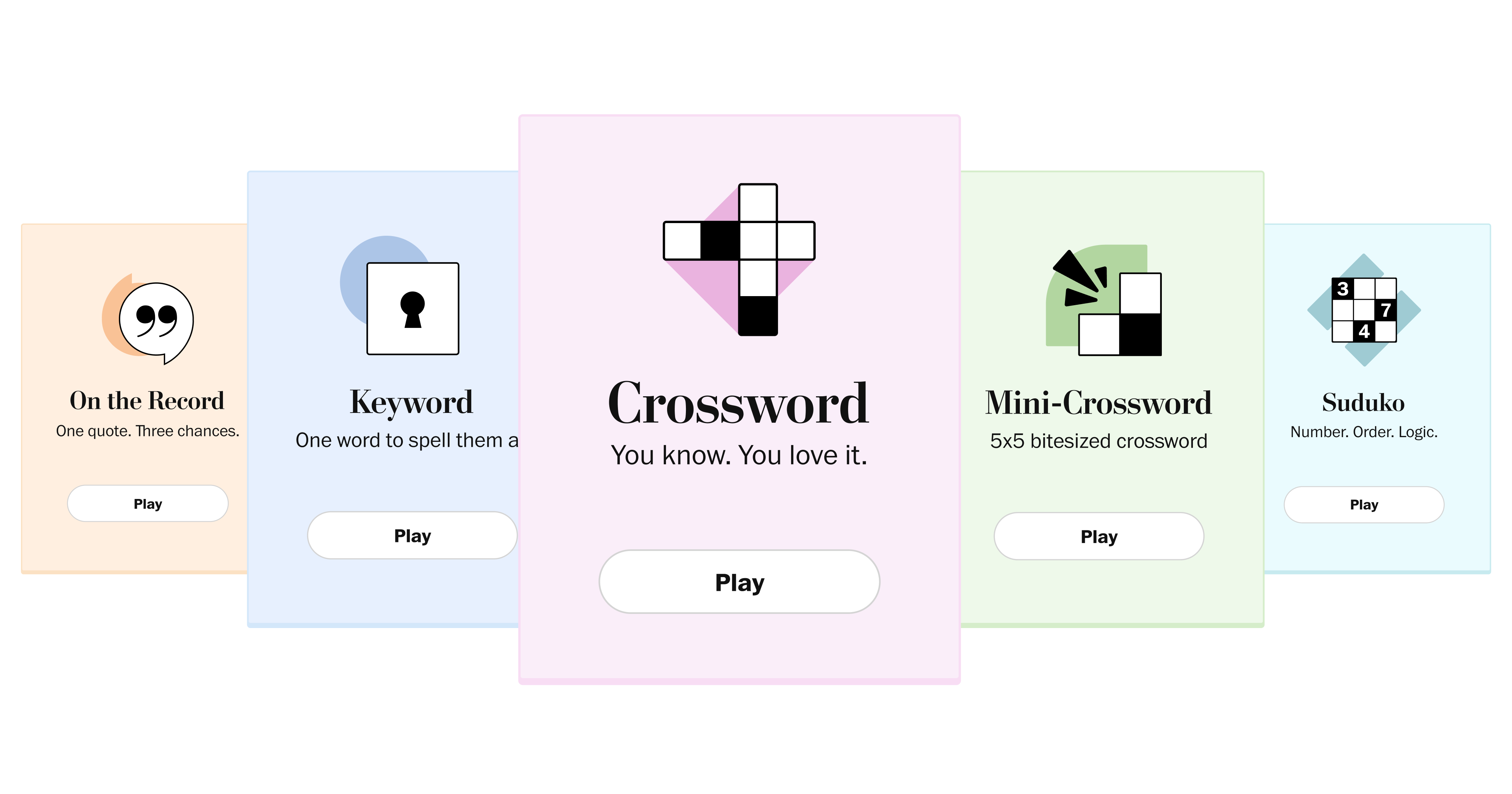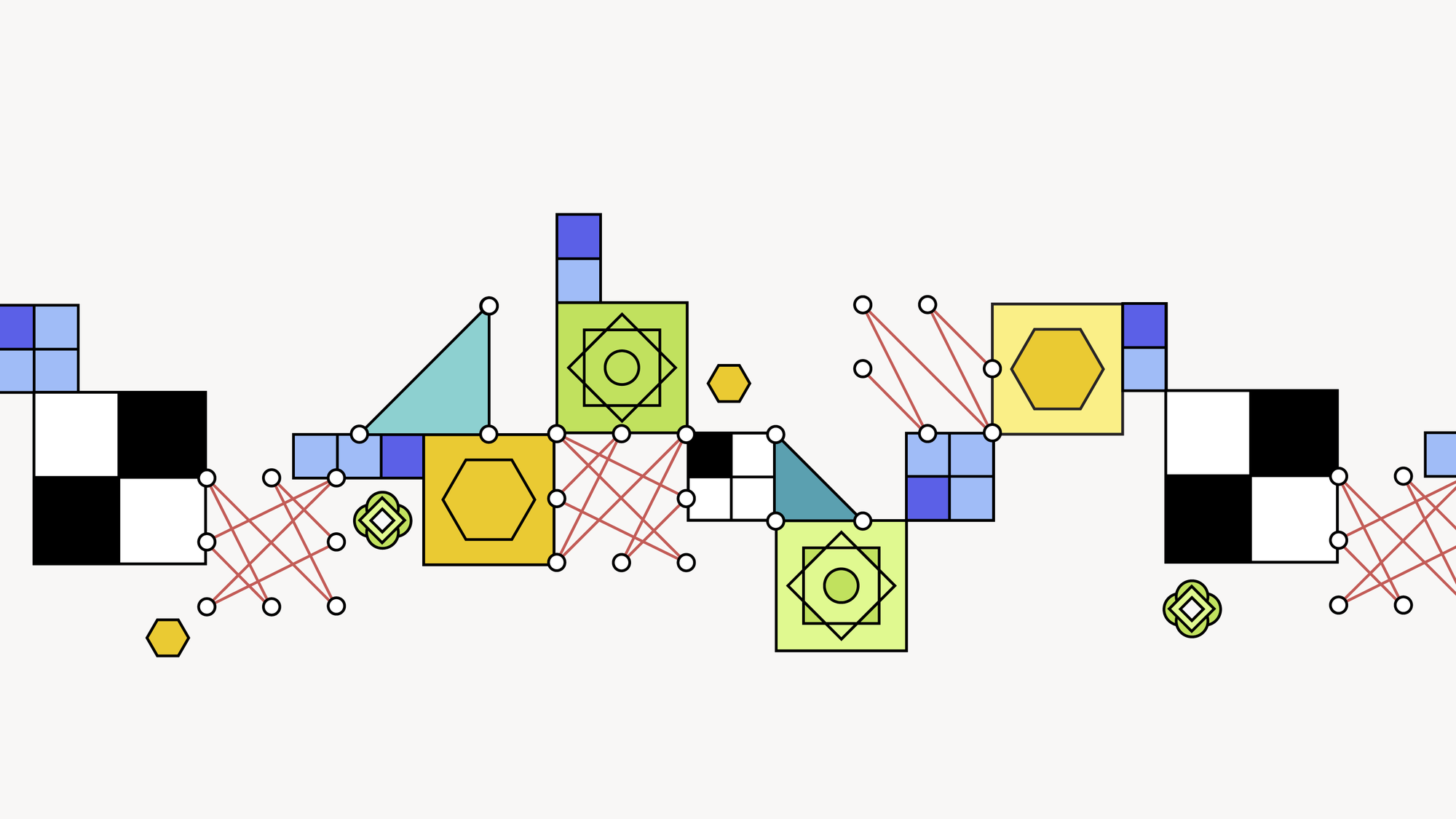If you’re somebody who even semi-regularly keeps up with the news, you’ve probably already heard this one: These days, The New York Times is a games (and cooking) app that happens to include news. Wordle, which NYT acquired from creator Josh Wardle in 2022 for somewhere “in the low seven figures,” is a juggernaut that the NYT declared had brought “tens of millions” of new users to the publication within months. Two years later, millions still play every week, alongside NYT’s other popular games. Now, with traditional news media on shakier legs than ever, NYT and other publications are working furiously to replicate that success.
Most recently, Hearst Publishing – which owns dozens of outlets including The San Francisco Chronicle, The Houston Chronicle, Cosmopolitan, and Esquire – acquired Puzzmo, a puzzle game platform headed up by indie developers Zach Gage and Orta Therox. Puzzmo games now appear in over 50 Hearst publications, as well as non-Hearst publications like Polygon (itself a gaming site) thanks to licensing deals. The Washington Post recently ramped up internal game efforts following The Times’ success. Even Defector began offering a weekly crossword puzzle last August.
Games and news might not seem like the most immediately intuitive combo, but that’s only if you view games through the lens of big-budget heavy hitters like Grand Theft Autos and Call of Duty. In reality, the current news game boom can be traced back to the crossword puzzle, the first of which – at least, in newspapers – appeared in 1913 (so a little before Grand Theft Auto came out). The pairing makes perfect sense: Crosswords are habit forming. While news ebbs and flows, readers continue to pick up publications for a reliable brain teaser.
"You can't predict the news. Some days it's crazy. Some days, it's completely a snoozefest,” Mike Hume, former editor of emerging products at The Washington Post (and also my former boss), told Aftermath. “But you're always going to have a crossword puzzle to play. In that way, you have these elements that are really good about building daily habits. And as a news provider, as a media company, that's what you want: You want somebody to come and check your site every day, to make it part of their daily routine."
You can't predict the news. Some days it's crazy. Some days, it's completely a snoozefest.
For publications, this simple dynamic is now more crucial than ever. News no longer only competes with news; it’s up against Netflix, Amazon, PlayStation, Minecraft, Roblox, TikTok, every social media app under the sun, and countless other schemes to monopolize our eyeballs. If you can get somebody for even a small fraction of their day, you’re already doing better than most. Meanwhile, the ad market for publications isn’t great, and between that, heinously incompetent executives, and Google deciding to bait and switch publications into oblivion (like Facebook before it), traditional media is facing an extinction event. Thanks in part to games like Wordle, Connections, Spelling Bee, and New York Times Crossword, NYT subscribers now spend more time playing games than they do reading news. Some barely read the news at all.
"The news can be kinda lumpy,” NYT head of games Jonathan Knight, who previously worked at triple-A publishers like EA and Activision, told Aftermath. “But games are a daily habit. What we see is that for subscribers who have taken the bundle … and engage with both news and games, you are far more likely to retain over the long period than any other combination we've got inside the company."

Defector, despite only dipping its toes into games for now, has experienced similar success with a program that was inspired by The Times.
“Every puzzle so far has been in the top-quartile of blogs in terms of new email registrations,” Jasper Wang, operations leader at Defector, told Aftermath. “Over 20 percent of existing subscribers have started playing at least one puzzle. The data on whether it's a worthwhile ongoing investment will come further down the line, when we get a sense of what retention boost we see on subscribers who play the crossword, but I do expect that the crosswords will pay for themselves, at the least, via retention uplift and new subscriber conversions."
While NYT purchased Wordle, it managed to build 2023 mega-hit Connections, a puzzle game in which players group words that share a common thread, from the ground up after the idea first emerged from an internal game jam in 2021. According to Vanity Fair, the game had ten million weekly active users as of November. It was also the third most-searched game on all of Google last year. These days, the NYT’s games division employs roughly 100 people and the Games app was downloaded over 10 million times last year.
"We are trying to make the next Wordle, but we're doing it in a very measured way,” Zoe Bell, NYT’s executive producer of games, whose background includes stints at Zynga and Big Huge Games, told Aftermath. “We have this philosophy about game design where you start with a wide funnel with all the ideas and you make decisions about whether or not you're gonna work with a few of them. And then you get smaller, and you prototype a few, and then you share a couple of those with the wider audience and see what sticks. We're not trying to invest too much in an idea that might not take off. Hopefully that produces a hit game, and it did with Connections. I think that's sort of proving that strategy.”
Like Wordle, Connections is engineered to shine on social platforms, with a simple color-based visual identity that maximizes shareability. The goal is to encourage players to tell stories about their daily in-game experiences.
"We absolutely think about 'What would be something I would want to share with my friends at the end of a new game?' We don't design the new game for that, but once we've designed the game, we're like 'What's a compelling story that I want to tell?'” said Bell. “In Connections, a compelling story is 'Oh, I got it wrong-wrong, and then I figured out what was going on and got everything else right' or 'I did perfect!' We think about that because we want you to share with your friends and tell your friends about the game. And if you've got some interesting little block or text or something to go with it, I think it makes you more likely to share and for them to be like 'Hey, what's that? I should go look into it.'"
We are trying to make the next Wordle, but we're doing it in a very measured way.
Social chatter around Connections has taken on a life of its own, with players on platforms like TikTok theorizing endlessly about how and why puzzles came to be and suggesting that they’re getting harder in response to social media discourse (an assertion NYT has denied). While the sheer magnitude of the game’s TikTok success was not expected, this type of engagement, according to Bell and Knight, is a feature, not a bug.
"Our take on Connections was to dedicate a full-time editor and constructor, Wyna Liu, to it,” said Knight. “You really get a sense of her voice coming through that puzzle. She's trying to trick you every day. And we're seeing fun social media content around that. She's become a little mini-celebrity and people are reaching out saying things like 'Wyna, are you OK?' but also like 'We hate you, but we love you at the same time.' That was the approach with the puzzle, what she wanted to do with it. It's this fun relationship between her and the solvers that feels very much at the surface versus a lot of games on the internet and in the App Store where the people behind it feel a bit more buried."
NYT’s games strategy is paying dividends during a time when other mainstream publications are struggling after the Trump presidency’s trainwreck appeal ceased to buoy numbers. Young people, especially, have proven elusive to publications like The Washington Post, with multiple studies finding that young people increasingly get their news from personalities on platforms like TikTok and Instagram, rather than from journalists or from platforms like Twitter and Facebook, where traditional media still holds some sway. This is less of a problem for The New York Times, whose own (admittedly cherry-picked) statistics say that 61 percent of NYTimes.com readers are Gen Z or Millennials. According to Knight, Wordle helped open the floodgates.
"Certainly Wordle broadened the demographic,” said Knight. “We brought in a much younger, more diverse, more international, more rural [crowd]. Pretty much across all those vectors, Wordle really broadened the audience relative to our news audience and our crossword puzzle audience."
The question other publications face is how to catch up when NYT has already lapped itself.
"Because of the strategy around the essential subscription, we've been able to get to a scale of users – we have over 10 million subscribers at the company – that allows you to invest in things and do things that it's hard for [other outlets] to do," said Knight.
That said, Knight is happy to see more publications spinning up their own games operations. "The more energy around the space, the better,” he said (though the games team’s permissive mentality did not stop The Times from recently sending DMCA takedown notices to hundreds of Wordle clones).

Puzzmo, headed up by longtime indie developer Zach Gage and a team of around 10 people compared to NYT’s 100, is going wide. The site is intended to function as a community-oriented platform that can exist across countless publications.
“What I noticed is that if you try to get into crosswords, you basically have to play the New York Times crossword because that is the only crossword that you can expect that you will be able to find a community around,” Gage told Aftermath. "That's not true anymore. If you want to play the Puzzmo crossword, there is a community. You can see it. You can see it on the leaderboards. You can go to the Discord. You can create a group and invite your friends. I think we are doing something really special in terms of bringing community to the space where the community has been really strained and the amount of work you have to do to have community around these kinds of games is really high. Which is weird, because the amount of work you have to do to have community around Fortnite is nothing. You just open up Fortnite. That's a big part of the platform for us."
This – rather than an instant smash hit game – is the best entry point into a quietly crowded market, believes Hearst VP of games Andrew Daines.
"[Puzzle games] are a genre where it's really hard to build a defensive moat around any one given title, because people rip stuff off,” said Daines. “We see our competitors do that. We see even indies ripping off other indies all the time. But a platform, a genuine platform – not just somebody slapping the word 'platform' on something – that's strong, that's defensible. ... Games come and go, but if people know that we're going to be publishing great games and have this history of their points, scores, and achievements, and their friend group is there, it's a place. That's really powerful."
Gage compared Puzzmo’s appeal to that of Steam and, for old heads in the audience, Xbox Live Arcade on the Xbox 360.
"I have a lot of fond memories of the original launch of XBLA and what they did – the paradigm shift that came of that,” said Gage. "When I set out to build Puzzmo, that was a huge part of it: I wanted people who played crosswords and who play word games and who played these sort of newspaper-style puzzles or daily games to have access to these kinds of features. I look at my wife playing Words With Friends with her mom and my mom playing Words With Friends with her mom and her mom playing Words With Friends with her brother, and it's like, all these people are basically using Words With Friends as a text app. But they're not allowed to make groups. That's just ridiculous."
Puzzmo is still a new venture with a relatively small suite of games, but it already includes some of Gage’s greatest hits like 2011 word game SpellTower and 2016 mobile game Really Bad Chess. Gage and the rest of the Puzzmo team are working on building more with a pervasive central philosophy: low floor, high ceiling.
All these people are basically using Words With Friends as a text app. But they're not allowed to make groups. That's just ridiculous
Chris Grant, group publisher at Polygon and The Verge, views what Puzzmo is doing as promising enough to dedicate an entire widget to on Polygon, even if it’s still obviously in an early state.
“What I told our folks internally when we were deciding if we were gonna say yes to this partnership or not was, the fact that their [version] one product out the gate is competitive with The Times at all is kinda wild,” Grant told Aftermath. “The Times has a giant war chest they've been building up and putting against games for a long time. And Puzzmo's coming out the gate with a very strong offering on the very first day. I'm excited to see how they evolve it."
Polygon’s Puzzmo partnership is interesting given that few games-focused publications offer games themselves. Grant admitted that it brings in "parts of a single digit of a percent of our revenue," but still views it as worthwhile. The rev share from a Puzzmo subscription obtained through Polygon is “not nothing” according to Grant, but in line with Gage’s own thoughts on the matter, it’s more a community-building play than anything else.
“I think the bigger advantage for me outside of a revenue amount is audience loyalty, time, and attention,” said Grant. “Having another thing to do when you go somewhere on your phone or your computer."
Grant also views the Puzzmo partnership as an interesting experiment in learning what games audiences are willing to pay for.
"In the gaming space, my general expectation is that most of the audience isn't going to pay [initially],” said Grant. “And so, what will they pay for? What is worth transacting more directly? Is it the work of the journalism that we put out? Yes or no. Maybe. I think that you're more likely to transact on the product level, providing some enhancement that people would pay for. But certainly games; people pay for games."
This, ultimately, gets to the heart of why there’s been a sudden – though characteristically still sort-of-slow – flood of interest in games from mainstream outlets in the past few years: Publications desperately need to figure out what people are willing to pay for and come back to in this day and age. Wordle gave them an answer.
"I think [publications] never fully understood how much potential crossword puzzles and other games have in terms of generating audience and retaining that audience through prolonged engagement," said Hume.
That’s massively important – more so than pretty much any other single factor – in the age of algorithms.
"You can't build a successful media company that is reliant on people coming in through the side door,” said Hume. “They have to have a one-to-one relationship with the brand. They [have to be able to] say, 'I know I'm getting value from this company' whether it's The Post, The Times, or whoever. 'I'm willing to pay money to enjoy this experience and support this experience, because I like it.' The same principle [exists] on YouTube and Twitch. ... 'I'm willing to pay for it because I don't want it to go away' is a very simple one-to-one relationship. It's not complex at all. You don't have to worry about algorithms changing."

The Washington Post’s game development effort could be considered both behind the times and behind The Times, offering only a small handful of in-house games like word game Keyword and news quiz On The Record in addition to crosswords (and a truly overwhelming page of over 100 unrelated games from third-party casual game company Arkadium). The Post has yet to regain its footing after tumbling from Trump-emboldened heights, offering buyouts to eliminate 240 jobs in late 2023, which (in part) prompted a strike. Games, according to Hume – who was one of many to leave The Post at the end of last year – represent a vein of still-untapped potential.
"The ad market is terrible,” he said. “There's very real news fatigue. There's tons of alternative sources for news that aren't even news agencies. You have to find ways to generate revenue and generate audience, and games absolutely could be part of that."
But first, publications like The Post have to take a page from The Times and meet audiences where they’re at.
"If you look at the average age of most crossword players, it's gonna skew older. There's some under-40 players, but by and large, it's print subscribers who are over the age of 55,” said Hume. "If you want a younger audience, you have to give that audience a game they're willing to interact with, whether that's text-based or it's something a little more immersive. … The biggest roadblock is traditional thinking. It's really hard to shake free of something that has been treated one way for so long."
Traditional thinking goes a long way toward explaining why mainstream publications seem largely uninterested in doing what they do best with games: covering them. Both The Times and The Post now regularly write about their own games with columns and newsletters, but their coverage of gaming as a whole is remarkably scant. WaPo’s Launcher vertical shut down last year, after – speaking from personal experience – being given the bare minimum of resources for much of its three-year run. (Aftermath co-founder Riley MacLeod and I both worked there.) As a result of video games existing across a variety of disciplines and straddling the line between tech and entertainment, Launcher reporters were some of the most versatile you could find in a news organization, but were rarely treated as such. WaPo now employs just one dedicated games reporter, Gene Park. The Times, meanwhile, continues to dabble in giving games their due without fully committing.
“[Games] are still treated as special, as opposed to just a major US entertainment business,” said Grant. “Take the Microsoft acquisition of Activision Blizzard [for example]. That's a wildly large acquisition and orders of magnitude larger than any other entertainment acquisition. It got covered, but it wasn't covered with a level of fervor and curiosity that, like, Disney buying Marvel was. That was $4 billion – a drop in the bucket compared to [Activision Blizzard’s $68.7 billion]. … It's still a big business story. It's still a big art story.”
The Times makes a distinction between the games it makes and the video games people play.
"We call them puzzle games, which is maybe splitting hairs a little bit, but puzzles are meant to be solved,” said Knight. “Games are only meant to be played. We certainly think people play our games, but they also solve them. That moment of finding the solution is so key to the satisfaction of the experience."
When planning out coverage of an industry that we historically haven't had consistent coverage of, we have to get there. We have to build up to that, to show readers why they should care.
That’s not to say reporters at The Times don’t see value in covering video games beyond the lucrative casual realm the company has created for itself. Last fall, NYT announced that it was “leveling up on the video game beat,” with three staffers from various desks – Jason Bailey, Kellen Browning, and Zachary Small – leading the charge, though other beats like art and the gig economy remain their primary focus from an output standpoint. Staffers from other desks and freelancers, meanwhile, have handled sporadic news hits and reviews. Still, this approach has resulted in the occasional feature-length piece, like Small’s February deep dive into the cultural impact of Final Fantasy VII.
"I have kind of a weird job because I'm mainly covering the art world and doing, like, money-laundering investigations and looking at the bodies illegally stored in museums,” Small told Aftermath. “There's a lot of things happening, but the video game coverage is part of what I was hired to do. It is a core piece. To talk about what it looks like on an operational basis is a little hard because we're also building this beat, which was at The Times ... there was a regular video game critic for many years in the 2000s. But it did fall by the wayside, and now we're building it back up."
This has resulted in many questions for a legacy publication whose reporters often work at a breakneck pace, but whose larger machinations can be slow to whir to life.
"A lot of the conversations I have with people are like, what does it mean to build up that coverage?” said Small. “How do we do that sustainably from both a human resources standpoint, where we're all really busy, and also in terms of a readership that largely doesn't follow video games as closely as maybe you or I do? … I think it probably is a little more than just 'This new game is coming out; it's gonna be really fun to play.' I think you expect a little bit of the highbrow sort of thing like 'This is Final Fantasy VII, and we're also going to look at the historical context of Japan in the 1990s' – sort of round things out in a way that might be a little unexpected for some video game coverage."

For now, that means lavish features for major releases like Final Fantasy VII Rebirth and last year’s Legend of Zelda: Tears of the Kingdom, which Small described as “the bare minimum.” In the future, Small would like for The Times to have “a regular place for reviews” and more deep dives into gaming culture akin to a piece they wrote last year about trans gamers. Investigative coverage, meanwhile, is a “long-term goal.”
“When planning out coverage of an industry that we historically haven't had consistent coverage of, we have to get there,” said Small. “We have to build up to that, to show readers why they should care."
Small said that NYT’s video game coverage is bringing in new audiences, but of course it’s nothing on the level of what the company’s Games app has achieved. In the year 2024, news is not enormously big business. While it might sound laughable now, it’s not impossible to imagine a future in which big mainstream publications divest from news and tilt even further in the direction of what makes them money: service journalism, cooking, and increasingly, games. Hume, however, believes that even as platforms and personalities rise to prominence, traditional news isn’t going anywhere.
"There's always going to be a place for news,” said Hume. “Whether it's profitable or not, information is essential. And you have to have people that are going to go out to report and get these stories and see these stories firsthand. That's an imperative, and I do think people are willing to pay for that. ... So [news] is never gonna be a vestigial organ. But I do think that there need to be smart ways to showcase value beyond that. Are there levers we can pull that generate interest, generate audience, and generate revenue that go beyond the news? That's going to be essential thinking."


